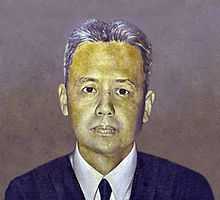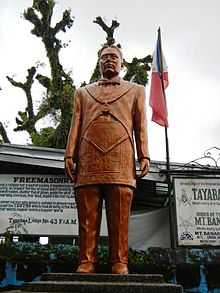José Abad Santos
| José Abad Santos | |
|---|---|
 | |
| 5th Chief Justice of the Supreme Court of the Philippines | |
| In office December 24, 1941 – May 2, 1942 | |
| Appointed by | Manuel L. Quezon |
| Preceded by | Ramón Avanceña |
| Succeeded by | José Yulo |
| Associate Justice of the Supreme Court of the Philippines | |
| In office June 18, 1936 – December 23, 1941 | |
| Nominated by | Herbert Hoover |
| Preceded by | Norberto Romuáldez |
| Succeeded by | Ricardo Paras |
| Secretary of Justice | |
| In office December 5, 1938 – July 16, 1941 | |
| President | Manuel L. Quezon |
| Preceded by | Jose Yulo |
| Succeeded by | Teofilo Sison |
| In office September 1, 1928 – June 18, 1932 | |
| Appointed by | Governor-General Henry L. Stimson Governor-General Dwight F. Davis Governor-General Theodore Roosevelt, Jr. |
| Succeeded by | Luis Torres |
| In office April 26, 1922 – July 17, 1923 | |
| Appointed by | Governor-General Leonard Wood |
| Preceded by | Quintin Paredes |
| Personal details | |
| Born | José Abad Santos y Basco February 19, 1886 San Fernando, Pampanga, Philippines |
| Died | May 2, 1942 (aged 56) Executed by firing squad Malabang, Lanao del Sur, Philippines |
| Resting place | Unknown |
| Spouse(s) | Amanda Teopaco |
| Children | José Abad Santos, Jr. (nicknamed Pepito)[1] Luz Santos Amanda Santos Osmundo Santos Victoria Santos |
| Alma mater | Santa Clara College, CA Northwestern University, IL George Washington University, Washington, D.C. |
| Religion | Methodist |
José Abad Santos y Basco (February 19, 1886 – May 2, 1942) was the fifth Chief Justice of the Supreme Court of the Philippines. He briefly served as the Acting President of the Commonwealth of the Philippines during World War II, in behalf of President Quezon after the government went in exile to the United States. After about two months, he was martyred by the Japanese forces for refusing to cooperate during their occupation of the country.
The former Chief Justice is the maternal grandfather of former Senator of the Philippines Jamby Madrigal.
Early life and career
José Abad Santos was born in San Fernando, Pampanga to Vicente Abad Santos and Toribia Basco. His brother, Pedro, would eventually emerge as a leading socialist leader during the Commonwealth era. In 1904, he was sent to the United States as a government pensioner. He finished a pre-law course at the Santa Clara College in Santa Clara, California; his Bachelor of Laws at Northwestern University in Evanston, Illinois; and his Masters of Laws at George Washington University in 1909. He was admitted to the Philippine Bar in 1911 and later served as Assistant Attorney at the Bureau of Justice from 1913 to 1917 .
In 1919, Abad Santos would become instrumental in laying the legal groundwork, as well as drafting the by-laws and constitution of the Philippine Women's University, the country and Asia's first private non-sectarian women's institute of higher learning. A staunch Methodist, Abad Santos worshiped at Central United Methodist Church along T.M. Kalaw Street in Ermita, Manila (then known as the Central Methodist Episcopal Church).
Government service
Department of Justice
He was later appointed as the first Filipino corporate lawyer of the Philippine National Bank, Manila Railroad Company and other government corporations. He went to the Department of Justice where he became Attorney-General, Undersecretary of Justice then Secretary of Justice from 1921 to 1923. In July 1923, he resigned as Secretary of Justice together with other department secretaries as a result of the controversy between Governor-General Leonard Wood and Filipino leaders.
Chief Counsel and Supreme Court
Abad Santos then served as Chief Counsel of the President of the Senate and the Speaker of the House of Representatives of the Philippines. In 1926, he went to the United States as head of the Philippine Educational Mission. He was again appointed Secretary of Justice in 1928 and re-appointed on July 1, 1931. In 1932, he became an Associate Justice of the Supreme Court. He became its Chief Justice on December 24, 1941. As part of the emergency reorganization of the Commonwealth government, Abad Santos, in his capacity as Chief Justice, was given the responsibilities previously handled by the Secretary of Justice (the position of Secretary of Justice was abolished for the duration of the war). Abad Santos accompanied the Commonwealth government to Corregidor, where on December 30, 1941, he administered the oath of office to President Quezon and Vice-President Osmeña for the second term they'd been elected to in November of that year. He also undertook, with Manuel Roxas, the supervision of the destruction of Commonwealth government currency to prevent its falling into enemy hands.
World War II
With the Japanese invasion rapidly advancing to the southern part of the Philippines, President Manuel L. Quezon was advised by General Douglas McArthur to establish a government in exile to the United States, Quezon invited Chief Justice Abad Santos to leave with him. The latter declined preferring to remain in the Philippines and carry on his work and stay with his family. On March 17, 1942 the day of Quezon's departure at Zamboanguita, Negros Oriental for the US by way of Australia, he appointed Abad Santos as the Acting President with full authority to act in the name of, and on behalf of the President of the Commonwealth of the Philippines in areas unoccupied by the Japanese.
Capture and execution
On April 11, 1942, Abad Santos, his son José, Jr. (nicknamed Pepito), Col. Benito Valeriano and two enlisted men were captured by the Japanese in Brgy. Tubod in Barili, Cebu while traveling by automobile to Toledo, Cebu.[1] He identified himself as the Chief Justice of the Supreme Court of the Philippines. He and his son were then taken to a concentration camp in Basak San Nicolas, Cebu City. When asked to cooperate with the Japanese, he refused. Although he had nothing to do with military operations, as acting president, they imputed to him the destruction of the bridges and other public works in Cebu done by the USAFFE foces to delay the invasion of the island.
The Japanese High Commander Kiyotake Kawaguchi took him and his son aboard a ship on April 26, 1942 thinking they were heading to Manila. Instead, they arrived on April 28 at Parang, Cotabato (now in Maguindanao). The next day they were brought to Malabang, Lanao, arriving on April 30. After two days confinement at Japanese camps, Chief Justice Abad Santos was called in front of Kawaguchi and was informed about the order of his execution. Before he was shot to death, he was able to talk to his son Pepito. His last parting words to his son were "Do not cry, Pepito, show to these people that you are brave. It is an honor to die for one's country. Not everybody has that chance." Jose Abad Santos was executed at 2:00 p.m., on May 2, 1942 under a tall coconut tree near a river bank. He refused to be blind-folded and the last cigarette offered to him.[1]
Grave site
Later that afternoon of May 2, 1942, two Japanese interpreters took Jose's son, Pepito, to his father's grave. It was a small mound - too small, Pepito thought, to hold his father’s remains if properly buried. On top of the grave lay a rock as large as a coconut. Pepito begged that he be allowed to mark the grave with a cross, but his request was denied.
After the war, an intensive search for the place where the hero was buried failed. Pepito did not find the hut and the trees, which would have served as points of reference for locating the grave. The area where the execution took place had been plowed and planted to root crops.[1]
Date of execution
The date of his execution is often reported as May 7, but as former Supreme Court Justice Ramón C. Aquino, Abad Santos' biographer put it, "This (May 7) was the date given by Pepito himself during his testimony at the trials of Generals Yoshihide Hayashi and Kiyotake Kawaguchi. But on the basis of the testimony of Keiji Fukui, the interpreter during Abad Santos's confinement, supported by notations in his diary, the date of Abad Santos' execution was definitely ascertained to be at two o'clock on the afternoon of May 2, 1942."[2]

.jpg)
Commemoration
- When the Philippine Women's University established its primary and secondary education divisions in 1949, they named the school as Jose Abad Santos Memorial School in honor of Abad Santos who was a former Chairman of the Board of Trustees of the university.
- The municipality of Trinidad in Davao del Sur province, created in 1948, was renamed as the Municipality of Jose Abad Santos in his honor in 1954.
- The Abad Santos Avenue is a 3-kilometre (1.9 mi) six to eight lane divided city street in Tondo, Manila.
- He is commemorated on the ₱1000-peso banknote of the Philippines together with Brigadier General Vicente Lim and Josefa Llanes Escoda, founder of the Girl Scouts of the Philippines, who were all martyred by the Japanese Imperial Army during the Second World War.
References
- Aquino, Ramón C. (1985) "Chief Justice José Abad Santos 1886-1942: A Biography" Phoenix Publishing House, Quezon City
| Legal offices | ||
|---|---|---|
| Preceded by Quintin Paredes |
Secretary of Justice 1922 – 1923 |
Succeeded by Luis P. Torres |
| Preceded by Luis P. Torres |
Secretary of Justice 1928 – 1932 |
Succeeded by Quirico Abeto |
| Preceded by Norberto Romuáldez |
Associate Justice of the Supreme Court of the Philippines 1932 - 1941 |
Succeeded by Ricardo Paras |
| Preceded by Ramón Avanceña |
Chief Justice of the Supreme Court of the Philippines 1941 - 1942 |
Succeeded by José Yulo |
| Wikimedia Commons has media related to José Abad Santos. |
|
